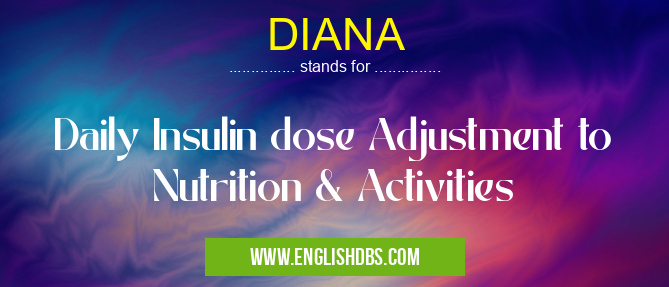What does DIANA mean in CLINICAL MEDICINE
DIANA stands for Daily Insulin dose Adjustment to Nutrition & Activities. It's an approach to managing diabetes that involves adjusting insulin doses based on meal content and daily activities.

DIANA meaning in Clinical Medicine in Medical
DIANA mostly used in an acronym Clinical Medicine in Category Medical that means Daily Insulin dose Adjustment to Nutrition & Activities
Shorthand: DIANA,
Full Form: Daily Insulin dose Adjustment to Nutrition & Activities
For more information of "Daily Insulin dose Adjustment to Nutrition & Activities", see the section below.
How DIANA Works
- Dietary Assessment: DIANA involves regular monitoring of daily food intake, including carbohydrate content, to determine the appropriate amount of insulin needed.
- Activity Monitoring: DIANA also considers the patient's physical activity levels, as exercise can affect blood glucose levels and insulin requirements.
- Personalized Insulin Adjustment: Based on the dietary and activity data, healthcare professionals calculate the optimal insulin dose for each day. This ensures that insulin levels match the body's needs.
Benefits of DIANA
- Improved Blood Glucose Control: DIANA can help individuals with diabetes achieve better blood glucose management by tailoring insulin doses to their individual requirements.
- Reduced Risk of Hypoglycemia: By adjusting insulin based on actual food intake and activity, DIANA reduces the risk of dangerously low blood sugar levels (hypoglycemia).
- Flexibility and Individualization: DIANA allows for customization based on the patient's lifestyle and preferences, making it more sustainable and effective.
Essential Questions and Answers on Daily Insulin dose Adjustment to Nutrition & Activities in "MEDICAL»CLINICAL"
What is DIANA?
How does DIANA work?
DIANA uses carbohydrate counting and activity monitoring to estimate insulin needs. Carbohydrate intake is quantified, and insulin doses are adjusted accordingly. Additionally, the impact of physical activity on blood sugar levels is considered to prevent hypoglycemia.
Who can benefit from DIANA?
DIANA is beneficial for people with type 1 or type 2 diabetes who require insulin therapy. It allows for greater flexibility and control over blood sugar levels, reducing the risk of hypoglycemia and hyperglycemia.
What are the advantages of DIANA?
DIANA offers several advantages:
- Improved blood sugar control
- Reduced risk of hypoglycemia and hyperglycemia
- Increased flexibility in meal planning and activity levels
- Enhanced understanding of diabetes management
What are the limitations of DIANA?
DIANA may have some limitations:
- Requires consistent carbohydrate counting and activity monitoring
- Can be time-consuming and complex for some individuals
- May not be suitable for everyone with diabetes
How can I start using DIANA?
To implement DIANA, it's recommended to consult with a healthcare professional who specializes in diabetes management. They can provide guidance on carbohydrate counting, insulin dosing, and activity monitoring.
Final Words: DIANA is a valuable tool for diabetes management that promotes personalized insulin therapy and improves blood glucose control. By considering both nutritional and activity factors, DIANA empowers individuals with diabetes to take an active role in their health and live healthier lives.
DIANA also stands for: |
|
| All stands for DIANA |
